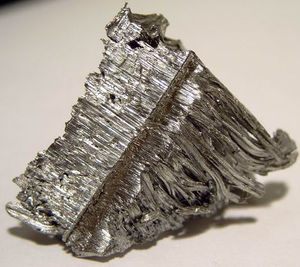Difference between revisions of "Holmium"
| Line 288: | Line 288: | ||
==Isolation== | ==Isolation== | ||
| − | Holmium can be obtained by reducing holmium salts, like holmium(III) chloride, with calcium metal. | + | Holmium can be obtained by reducing holmium salts, like holmium(III) chloride, with [[calcium]] metal in a thermite-like reaction. |
==Projects== | ==Projects== | ||
Revision as of 23:06, 26 December 2017
 | |||||
| General properties | |||||
|---|---|---|---|---|---|
| Name, symbol | Holmium, Ho | ||||
| Appearance | Soft, silvery white metal | ||||
| Holmium in the periodic table | |||||
| |||||
| Atomic number | 67 | ||||
| Standard atomic weight (Ar) | 164.93033(2) | ||||
| Group, block | , f-block | ||||
| Period | period 6 | ||||
| Electron configuration | [Xe] 4f11 6s2 | ||||
per shell | 2, 8, 18, 29, 8, 2 | ||||
| Physical properties | |||||
| Silvery-white | |||||
| Phase | Solid | ||||
| Melting point | 1734 K (1461 °C, 2662 °F) | ||||
| Boiling point | 2873 K (2600 °C, 4712 °F) | ||||
| Density near r.t. | 8.79 g/cm3 | ||||
| when liquid, at | 8.34 g/cm3 | ||||
| Heat of fusion | 17 kJ/mol | ||||
| Heat of | 251 kJ/mol | ||||
| Molar heat capacity | 27.15 J/(mol·K) | ||||
| pressure | |||||
| Atomic properties | |||||
| Oxidation states | 3, 2, 1 (a basic oxide) | ||||
| Electronegativity | Pauling scale: 1.23 | ||||
| energies |
1st: 581 kJ/mol 2nd: 1140 kJ/mol 3rd: 2204 kJ/mol | ||||
| Atomic radius | empirical: 176 pm | ||||
| Covalent radius | 192±7 pm | ||||
| Miscellanea | |||||
| Crystal structure | Hexagonal close-packed (hcp) | ||||
| Speed of sound thin rod | 2760 m/s (at 20 °C) | ||||
| Thermal expansion | 11.2 µm/(m·K) (poly) | ||||
| Thermal conductivity | 16.2 W/(m·K) | ||||
| Electrical resistivity | 8.14·10-7 Ω·m (poly) | ||||
| Magnetic ordering | Paramagnetic | ||||
| Young's modulus | 64.8 GPa | ||||
| Shear modulus | 26.3 GPa | ||||
| Bulk modulus | 40.2 GPa | ||||
| Poisson ratio | 0.231 | ||||
| Vickers hardness | 410–600 MPa | ||||
| Brinell hardness | 500–1250 MPa | ||||
| CAS Registry Number | 7440-60-0 | ||||
| History | |||||
| Discovery | Jacques-Louis Soret (1878) | ||||
Holmium is a lanthanide with the atomic number 67 and the symbol Ho. It is a gray metal that is reactive and slightly magnetic at room temperature. Holmium is difficult to find and somewhat expensive, but has some interesting properties regarding its magnetism and narrow absorption bands.
Contents
Properties
Physical properties
As a lanthanide, holmium resembles is neighboring elements strongly. It is paramagnetic, enough to be visibly lifted by a neodymium magnet. Its trivalent salts show dramatic color changes depending on the light source: they appear yellow in natural daylight, but vividly pink under compact fluorescent lighting, and very slightly pink under tube lighting.
Chemical properties
Holmium is a strong reducing agent and will readily react with weak oxidizers. It burns in air with a yellow or green flame to form holmium oxide. (The green color is likely the true color of burning holmium; the yellow color may be black-body radiation from the products.) Holmium is almost exclusively trivalent, and it is extremely difficult to reduce or oxidize holmium salts. It also reacts with the halogens to form colorful halides, which have the same color-changing properties under different light sources.
Holmium carbonate may form a soluble complex, but can be broken by addition of hydrogen peroxide.
Holmium trifluoroacetate and holmium trifluoromethanesulfonate (triflate) are relatively recently discovered catalysts for organic reactions. Even though they are Lewis acids, they do not hydrolyze readily and can be used in numerous solvents. Other lanthanide triflates have been investigated for catalytic activity.
Availability
Holmium is more common than iodine on Earth, but it is very hard to find. For a lanthanides, it is cheaper than some other metals. One source for holmium, as well as other rare earth metals, is Metallium. It is sold in 5 gram and 50 gram sizes, as well as rods, ampoules, and coins. Holmium and its compounds are occasionally sold on eBay as well.
Isolation
Holmium can be obtained by reducing holmium salts, like holmium(III) chloride, with calcium metal in a thermite-like reaction.
Projects
- Make holmium compounds
- Color changing crystals.
- Magnet polepieces?
Safety
Storage
Bulk holmium metal is stable in air indefinitely. As a powder or fine turnings, it may be extremely flammable, and should be kept away from ignition sources.
Toxicity
Holmium and its compounds have not been thoroughly investigated for toxicity, but no adverse effects have been reported from exposure.
Flammability
Small pieces of holmium metal or powder are flammable. Class D fire extinguishers should be readily available when working with large amounts of holmium near an open flame. Water should never be used to extinguish burning holmium, as it will aggravate the flame.
Disposal
Due to holmium's rarity, it's best to recycle it.
References
- flickr.com/photos/37388341@N00/2696039566/in/photostream/
- flickr.com/photos/37388341@N00/2381429226/